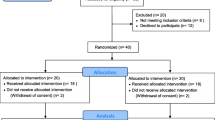Abstract
Purpose
This study was designed to compare the effects of premedication with dexmedetomidine and midazolam on post-electroconvulsive therapy (ECT) agitation (which patients had experienced previously and had been resistant to treatment). In addition, we aimed to evaluate the duration of convulsion, the propofol requirement, the recovery time, and patients’ satisfaction during and after ECT.
Methods
Fifteen patients with depressive episodes of bipolar disorder and nonbipolar recurrent depression and patients who underwent a series of three consecutive ECT treatments were studied as a crossover design. In this double-blind and placebo-controlled study, patients were randomly allocated to receive either dexmedetomidine, 0.5 μg·kg−1 (group Dex), midazolam, 0.025 mg·kg−1 (group Dor), or saline (group C) in a total volume of 20 ml given intravenously 10 min before the induction of anesthesia. Propofol was administered until the patients did not respond to a verbal command.
Results
The mean duration of convulsive activity was longer in group Dex than in group C and group Dor (P < 0.05). The total dose of propofol requirement in group Dor and group Dex was lower than that in group C (P < 0.05). Agitation scores in both groups Dor and Dex were significantly lower than scores in group C (P < 0.05) at 10 and 15 min after ECT.
Conclusion
Premedication with low-dose intravenous dexmedetomidine, 0.5 μg·kg−1 or midazolam, 0.025 mg·kg−1 before ECT may be useful in managing treatment-resistant agitation after ECT, without adverse effects.
Similar content being viewed by others
References
Ding Z, White PF. Anesthesia for electroconvulsive therapy. Anesth Analg. 2002;94:1351–1364.
Hayashi Y, Maze M. Alpha 2 adrenoceptor agonists and anaesthesia. Br J Anaesth. 1993;71:108–118.
Rasmussen KG, Knapp RG, Biggs MM, Smith GE, Rummans TA, Petrides G, Husain MM, O’Connor MK, Fink M, Kellner CH. Data management and design issues in an unmasked randomized trial of electroconvulsive therapy for relapse prevention of severe depression: the Consortium for Research in Electroconvulsive Therapy trial. J ECT. 2007;23:244–250.
Swartz CM. Electroconvulsive therapy emergence agitation and succinylcholine dose. J Nerv Ment Dis. 1990;178:455–457.
Liston EH, Sones DE. Postictal hyperactive delirium in ECT: management with midazolam. Convuls Ther. 1990;6:19–25.
Auriacombe M, Reneric JP, Usandizaga D, Gomez F, Combourieu I, Tignol J. Post-ECT agitation and plasma lactate concentrations. J ECT. 2000;16:263–267.
Fu W, Stool LA, White PF, Husain MM. Is oral clonidine effective in modifying the acute hemodynamic response during electroconvulsive therapy? Anesth Analg. 1998;86:1127–1130.
Simpson KH, Halsall PJ, Carr CM, Stewart KG. Propofol reduces seizure duration in patients having anaesthesia for electroconvulsive therapy. Br J Anaesth. 1988;61:343–344.
Wijeysundera DN, Naik JS, Beattie WS. Alpha-2 adrenergic agonists to prevent perioperative cardiovascular complications: a meta-analysis. Am J Med. 2003;114:742–752.
Labbate LA, Miller JP. Midazolam for treatment of agitation after ECT. Am J Psychiatry. 1995;152:472–473.
Devanand DP, Sackeim HA. Use of increased anesthetic dose prior to electroconvulsive therapy to prevent postictal excitement. Gen Hosp Psychiatry. 1992;14:345–349.
Hines AH, Labbate LA. Combination midazolam and droperidol for severe post-ECT agitation. Convuls Ther. 1997;13:113–114.
Grant SA, Breslin DS, MacLeod DB, Gleason D, Martin G. Dexmedetomidine infusion for sedation during fiberoptic intubation: a report of three cases. J Clin Anesth. 2004;16:124–126.
Fink M. Post-ECT delirium. Convuls Ther. 1993;9:326–330.
Vishne T, Amiaz R, Grunhaus L. Promethazine for the treatment of agitation after electroconvulsive therapy: a case series. J ECT. 2005;21:118–121.
Sato M, Tanaka M, Umehara S, Nishikawa T. Baroreflex control of heart rate during and after propofol infusion in humans. Br J Anaesth. 2005;94:577–581.
Moscrip TD, Terrace HS, Sackeim HA, Lisanby SH. Randomized controlled trial of the cognitive side-effects of magnetic seizure therapy (MST) and electroconvulsive shock (ECS). Int J Neuropsychopharmacol. 2006;9:1–11.
Loimer N, Hofmann P, Chaudhry HR. Midazolam shortens seizure duration following electroconvulsive therapy. J Psychiatr Res. 1992;26:97–101.
O’Reardon JP, Takieddine N, Datto CJ, Augoustides JG. Propofol for the management of emergence agitation after electroconvulsive therapy: review of a case series. J ECT. 2006;22:247–252.
Taylor S. Electroconvulsive therapy: a review of history, patient selection, technique, and medication management. South Med J. 2007;100:494–498.
Fu W, White PF. Dexmedetomidine failed to block the acute hyperdynamic response to electroconvulsive therapy. Anesthesiology. 1999;90:422–424.
Begec Z, Toprak HI, Demirbilek S, Erdil F, Onal D, Ersoy MO. Dexmedetomidine blunts acute hyperdynamic responses to electroconvulsive therapy without altering seizure duration. Acta Anaesthesiol Scand. 2008;52:302–306.
McCormick AS, Saunders DA. Oxygen saturation of patients recovering from electroconvulsive therapy. Anaesthesia. 1996;51:702–704.
Author information
Authors and Affiliations
About this article
Cite this article
Mizrak, A., Koruk, S., Ganidagli, S. et al. Premedication with dexmedetomidine and midazolam attenuates agitation after electroconvulsive therapy. J Anesth 23, 6–10 (2009). https://doi.org/10.1007/s00540-008-0695-2
Received:
Accepted:
Published:
Issue Date:
DOI: https://doi.org/10.1007/s00540-008-0695-2




